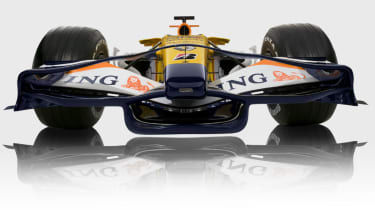20 things you didn't know about F1
What does it take to build and run a modern Formula 1 car? Prepare to be amazed as our tech expert, Ralph Hosier, explains all
1 Starting next year, those little protuberances that currently festoon F1 car bodies will be banned. They make it difficult to see the sponsors’ logos, and as sponsorship pays the bills…
Rear wings will be much smaller from 2009 too. Currently an overtaking car is heavily affected by the rear wing of the car in front, so it’s hoped the change will result in more overtaking. To counter the loss of downforce, slick tyres are back, so cornering will rely much more on mechanical grip, and front wings will get bigger, giving more of an F3 look.
2 To help develop its cars’ aerodynamics, ING Renault F1 Team’s Oxfordshire site has a wind tunnel with a long, flat, rolling-road floor, so the air goes under the car at the correct speed. The wind tunnel is operational 24 hours a day, seven days a week.
3 The Kinetic Energy Recovery Systems being introduced in ’09 will allow some of the car’s braking energy to be stored and then released on demand, a bit like the old turbo era’s ‘push to pass’ buttons. Only so much energy may be released per lap, and with only a 0.2sec advantage per lap available, effectiveness will depend entirely on the driver.
As a lap starts and ends at the finish line, it would be feasible to release one lap’s energy just before the line and the next lap’s energy immediately after, giving a double hit for overtaking a particularly troublesome opponent.
4 An F1 car is about 80 per cent carbonfibre, which arrives as a floppy woven-fabric sheet, already resin impregnated, ready for laser cutting. The weave is chosen for the desired characteristics, like strength in one direction and more flexibility in the other.
The fabric is laid-up on computer-generated resin moulds in a clean room – a single human hair can cause a stress crack, leading to the part failing. It’s then baked at between 45°C and 170°C to get the right characteristics.
5 Even the brakes are carbon. They don’t work well until operating at 1900°C, though, so they have shields to keep the heat in!
6 Not all the parts on an F1 car are light. Tungsten ballast weights are distributed round the 500kg car to bring it up to the 605kg minimum weight (including driver) required by the regs. A pint of tungsten weighs over 11kg.
The car is made as light as possible and ballast added to fine-tune the handling. For instance, Alonso likes understeer and so has more ballast at the front. More generally, circuits like Monaco need weight over the front wheels for grip in the slow, tight corners, while Monza requires a more even balance for its long, sweeping curves.
7 The driver’s seat in an F1 car is little more than a carbonfibre shell, weighing in at just 200g. It contains a number of buckles to allow an unconscious driver to be lifted out still in the seat, thus protecting their spine.
8 Renault’s current RS27 2.4-litre V8 has 700bhp yet weighs just 100kg. After each race the engines are parted from the chassis and returned to the engine factory, near Paris, for analysis and maintenance.
9 The engine oil and fuel are considered as engine components and form integral parts of the design. Oil is carefully engineered to give the best performance (low drag), durability (under pressures equivalent to 13 F1 cars balanced on a pound coin) and cooling (oil jets cool the underside of the piston at 300°C).
Samples are taken not only to see how the oil itself has survived, but also to check for metal and fuel content to understand engine wear. Oil research and development is one of the few things in F1 to directly benefit ordinary road cars.
10 F1 fuel has to be 99 per cent the same as road fuel. The remaining 1 per cent is adjusted to give custom fuels for increased peak power (up to 4bhp difference, each bhp giving a 15 yard advantage per lap), mid-range acceleration or range. Unfortunately you can’t have all three, so the blend is tweaked to suit the pit-stop strategy and circuit.
Fuel quality is tested by the FIA to an accuracy similar to detecting one cup of sugar in Loch Ness.
11 Shell is the only company to have a track-side laboratory at every race to test fuel and oil samples. It occupies a quarter of the six-million-dollar Ferrari mobile engineering lab.
12 Each car’s Inconel nickel super-alloy exhaust manifold can be tuned for each circuit – slightly longer for more torque on twisty circuits; shorter for high power on fast circuits. The metal is stronger than titanium and copes easily with the 1000°C-plus, exhaust temperature.
13 The technical support at each event is massive. Renault alone takes 17,000 spare parts and 40 tons of equipment. Ten artics are used to transport it all, with the cars carried at the top of the trailers because they are much lighter than the parts and tools carried in the immaculate lockers beneath.
14 Race teams arrive in stages. Workshops and communications systems are set up on the Monday; Wednesday sees the engineers arrive; Thursday the drivers turn up for press and promo work. By Friday a complete engineering village is in full operation and the cars are ready for practice. About 100 people per team work on a race event, 60 on a test session.
McLaren used to arrive a few days before everyone else in order to fit granite tiles to their allocated pit garage and give it a complete makeover! Ex-McLaren garages are much sought after…
15 Most F1 hardware originates from the Midlands. Six of the ten F1 constructors are based in the UK. Historically around 40 per cent of a Ferrari F1 car came from the UK, while 90 per cent of the Renault F1 car is made here.
Renault’s F1 team employs 550 people, with 15 joining on secondment from the road car side each year, thus helping F1 technology transfer back to the company’s more
16 The steering wheel is the centre of activity in an F1 car. In addition to its primary role, the carbonfibre wheel also serves as home to the gear selector, clutch, on-board diagnostics system, communications buttons and the engine and chassis controls. No wonder it costs around £20,000…
There is quite an art to using the two clutch paddles. In order to get a quick reaction at the race start without stalling, the right paddle is pulled in fully, while the left one is held halfway with a finger jammed underneath. Then when the race starts, the right paddle is dropped and the clutch goes to the position held by the left, giving optimum pull away.
17 Each car constantly transmits a huge amount of data – from suspension loads to exhaust temperature – back to the pit crew. If a problem develops, a plan is devised, which may involve changes in the pits or the driver being asked to adjust settings (which can no longer be changed by remote control) whilst still racing. So the steering wheel also has controls for fuel mixture, damper settings, etc.
18 Bridgestone handles the management and fitting of all tyres. Each driver has a dedicated Bridgestone engineer to look after his annual allocation of tyres – seven sets with a hard compound, seven sets soft. All tyres have to be used at least once and have a serial number checked by race officials.
19 Tyre pressures make an enormous difference to an F1 car’s handling, so they are constantly checked by both the team and Bridgestone. Ordinary air has water in it, which expands horribly, so tyres are filled with dried air or nitrogen.
Despite their size, a typical rear wheel and tyre weighs only around 10kg. F1 regs still mandate a 13in wheel, which necessitates a high-profile tyre, so about half the total suspension movement is in the tyre.
An F1 tyre’s operating temperature is over 100°C. An extreme wet tyre can pump out 80 litres of water per second in an impressive ‘rooster tail’.
20 Development of a new F1 car takes 18 months, so next year’s cars are already being created.




